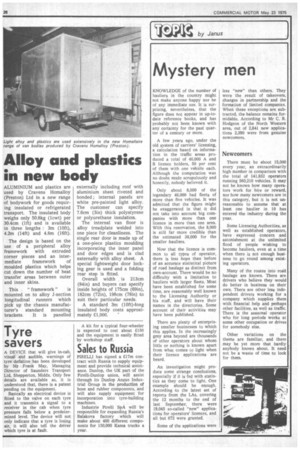Mystery men
Page 28

If you've noticed an error in this article please click here to report it so we can fix it.
KNOWLEDGE of the number of hauliers in the country might not make anyone happy nor be of any immediate use. It is surprising, nevertheless, that the figure does not appear in up-todate reference books, and has probably not been known with any certainty for the past quarter of a century or more.
A few years ago, under the old .system of carriers' licensing, a calculation based on •information in the traffic areas produced a total of 46,000 A and B licence holders, 50 per cent of them with one vehicle each. Although the computation was no doubt made scrupulously and honestly, nobody believed it.
Only about 8,000 of the legendary 46,000 had fleets of more than five vehicles. It was admitted that the figure might be exaggerated in that it did not take into account big companies with more than one licence in more than one area. With this reservation, the 8,000 is still far more credible than the estimated 38,000 for the smaller hauliers.
Now that the licence is common to all types of operator, there is less hope than before of an accurate statistical picture of road haulage as distinct from own-account. There would be no difficulty with a limitation to hauliers with Larger fleets. Most have been established for some time, are reasonably well known to •the Licensing Authority or his staff, and will have their names in the directories. Some account of their activities may have been published.
There are plenty of enterprising smaller businesses to which this applies. In the increasingly grey area beyond are thousands of other operators about whom little or nothing is known apart from what comes to light when their licence applications are heard.
An investigation might produce some strange conclusions, especially if it is fed with statistics as they come to light. One example should be enough. According to the latest set of reports from the LAs, covering the 12 months to the end of last September, there were 19,045 so-called "new" •applications for operators' licences, and all but 672 were granted'.
Some of the :applications were less "new" than others. They were the result of takeovers, changes in partnership and the formation of limited companies. When these exceptions are subtracted, the balance remains formidable. According to Mr C. R. Hodgson of the North Western area, out of 2,841 new applications 2,390 were from genuine newcomers.
Newcomers
There must be about 15,000 every year, an extraordinarily high number in comparison with the total of 141,832 operators running 560,210 vehicles. It may not be known how many operators work for hire or reward, nor how many newcomers are in this category, but it is not unreasonable to assume that at least one haulier in 10 has entered the industry during the year.
Some Licensing Authorities, as well as established operators, have expressed concern and astonishment at the unlimited flood of people wishing to become hauliers, even at a time when there is not enough business to go round among existing operators.
Many of the routes into road haulage are known. There are drivers who believe they would do better in business on their own. There are other less independent drivers working for a company which supplies them with financial help and perhaps other facilities, as well as traffic. There is the seasonal operator who for long periods works at some other occupation or drives for somebody else.
Other variations on the theme are familiar, and there may be yet more that hardly anybody knows about. It need not be a waste of time to look for them.






























































































